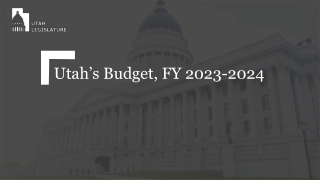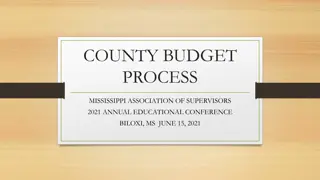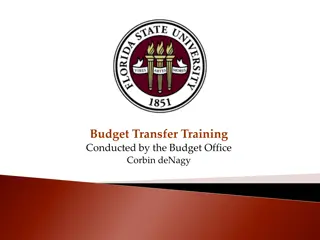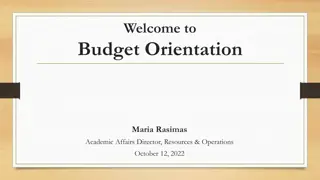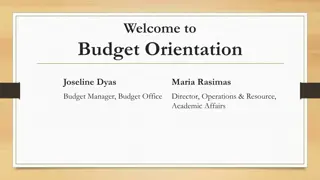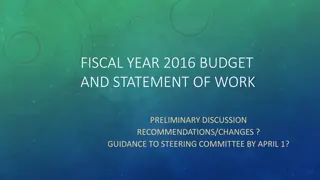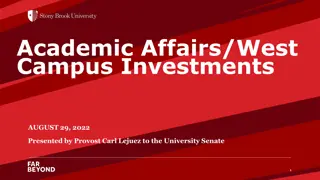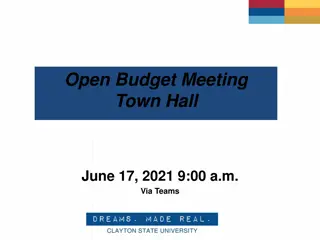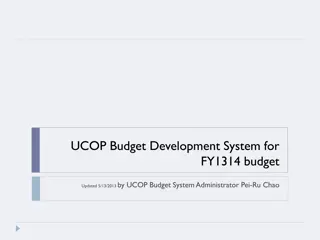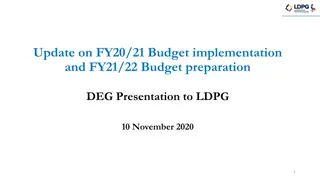Academic Affairs Budget Management: Overview and Best Practices
Explore the intricacies of academic budget management through the lens of new department chair orientation at CSUN. Delve into budgeting practices, funding strategies, and tools essential for effective financial resource planning in academic affairs. Learn about the significance of budgets, the difference between accounting, budgeting, and finance, and the fundamentals of fund accounting. Gain insights into CSUN's budget structure and its place within the broader CSU General Fund Budget. Understand the importance and multifaceted roles of budgets as planning tools, communication instruments, and reflections of organizational values in the academic setting.
Download Presentation

Please find below an Image/Link to download the presentation.
The content on the website is provided AS IS for your information and personal use only. It may not be sold, licensed, or shared on other websites without obtaining consent from the author. Download presentation by click this link. If you encounter any issues during the download, it is possible that the publisher has removed the file from their server.
E N D
Presentation Transcript
Academic Affairs Budget New Department Chair Orientation August 20, 2021 Callie Juarez Director of Academic Budget Management
Agenda Introductions Budget Overview CSUN Budget Department Budgeting Faculty Position Funding Best Practices and Tools Q&A
The Resource Planning Environment in Academic Affairs Department of Academic Resources and Planning
What is a budget? noun: an estimate, often itemized, of expected income (or allotment) available for spending that is based on a plan for how it will be spent for a given period of time.
A budget can serve multiple purposes: A forecast of planned revenues, expenditures and saving A tool for the allocation of current and anticipated financial resources A means to promote good management A controlling instrument A method of communication A reflection of the organizational values
What is the difference between accounting, budgeting and finance? Source: www.wacubo.org
Funds and Fund Accounting General Accounting An accounting system that emphasizes accountability rather than profitability Fund Accounting Self-balancing set of accounts, with identified sources of income and segregated for specific uses in accordance with laws, regulations, or special restrictions or limitations
CSU Budget Northridge is 6.3% of Total CSU General Fund Budget Total CSUN General Fund Budget = $460M
What is a budget? A PLAN! CSUN budget is $1 million less than 21/22 What happened weren t budgets restored?? What is in the plan at the CSU for Northridge? Retirement Benefits (above state funded at 2013) Return of funds to the CSU for system priorities Restoration of 20-21 General Fund Reduction GI 2025 AB 1460 Ethnic Studies Reduction in estimated FTES
CSUN Budget (Budget Dashboard OpenBook) https://www.csun.edu/afvp/budget
CSUN Policy on Fiscal Responsibility Ensure that: Expenditures don t exceed available resources Funds expended for intended purposes in appropriate time period Use internal controls to protect from misuse Correctly classify receipts and expenditures Comply with campus policies
Fees in General Fund (appropriations, allocations, and fee revenue) 48501 Research, Scholarship, and Creative Awards (RSCA) 48518 Typical State- Side Funds in Academic Departments Campus Quality Fee (CQF) Course materials - 48520 Student support - 48521 Technology 48522 State Trust Fund (includes TExL MOU revenues, IRA, etc.) 496XX, 444XX, etc. Lottery Fund 48101
Department Auxiliary Funds Auxiliary Funds (separate 501(c)(3) entities) The University Corporation (TUC) TUC provides commercial and administrative services to CSUN and also manages sponsored programs. Sponsored programs grantor is an agency of the local, state, or federal government. CSUN Foundation The CSUN Foundation is responsible for accepting, managing, investing and disbursing all CSUN related philanthropic funds. Scholarships Restricted/unrestricted gifts
The Decentralized Model Principles Communication and Disclosure ERC Recommendation College Budget Model Clarity of Business Practices Facilitate Sharing of Information and Open Communication Balanced Budgets Meet FTES Targets Continuity/Consistency of Practices Defensible Systems (audit readiness) Accountability
Role of the College Directors vary and generally include: Part of college leadership team Advisor to dean on resource matters Member of administrative council Resource for department chairs, faculty, and staff Resource management Budget planning and management Schedule of Classes planning (with dean or associate dean) Technology support Staff human resources Space assignments and utilization Business process improvement Much, much more! Role of the Director of Finance and Operations
Meet with your Director of Finance and Operations College Director Natali Papazyan Mike Curb College of Arts, Media, and Communication Cathleen Fager David Nazarian College of Business and Economics Fred Moreno Michael D. Eisner College of Education Magda Azouz College of Engineering and Computer Science Todd Oberson College of Health and Human Development Janene White College of Humanities Nidia Goitia College of Science and Mathematics Serinah Gabrelian College of Social and Behavioral Sciences Jamie Skeggs Oviatt Library
Educational Resource Committee of the Academic Senate (ERC) Recommendation on College Budgets 1999 Open budget reporting and consultation process Resources and allocations for all departments, centers, and programs Contingency funds Maintain Communicate to department chairs
How Does Faculty Attrition Affect the Budget? Example: Retiring Faculty Salary Replacement Salary Retained in College (24 units AY) (48,442) Salary Savings $98,442 $50,000 Example: Assume 15 Full-time Retirements and 20 FERPs Total Contribution to Attrition Salary Savings Full-Time $750,000 FERPs 500,000 $1,250,000 Commitments: Annual Cost of Faculty Promotions Annual Cost of Staff Promotions/Actions Net Available for Redistribution* *for faculty positions, initiatives, unfunded mandates ($650,000) (400,000) $200,000
Tenure-Track Faculty Position Funding Sources Funded enrollment growth Internal Academic Affairs salary savings from attrition
FTES Growth Funding for Lecturers Funding for schedule adjustments Process initiated by departments and colleges when over- enrolled. Faculty positions funded at replacement rate and when college exceeds planned internal target. o Undergraduate Studies approved FTES funded as follows: o Increase to class limit funded at 50% o Additional sections funded at 100%
Managing the Schedule This is the number one area of control for department chairs Effective use of physical, fiscal, and human resources Effectively deploy tenured and tenure-track faculty in order to maximize enrollments using fixed costs Monitor/eliminate low enrolled sections
Other Best Practices Regular (monthly) account reconciliation Line-item budgeting Questica Generation of alternative funds Extended Learning, fundraising, grants/IDC Others? Planning Equipment refresh Wish lists (for windfalls, donors, etc.) Contingencies


